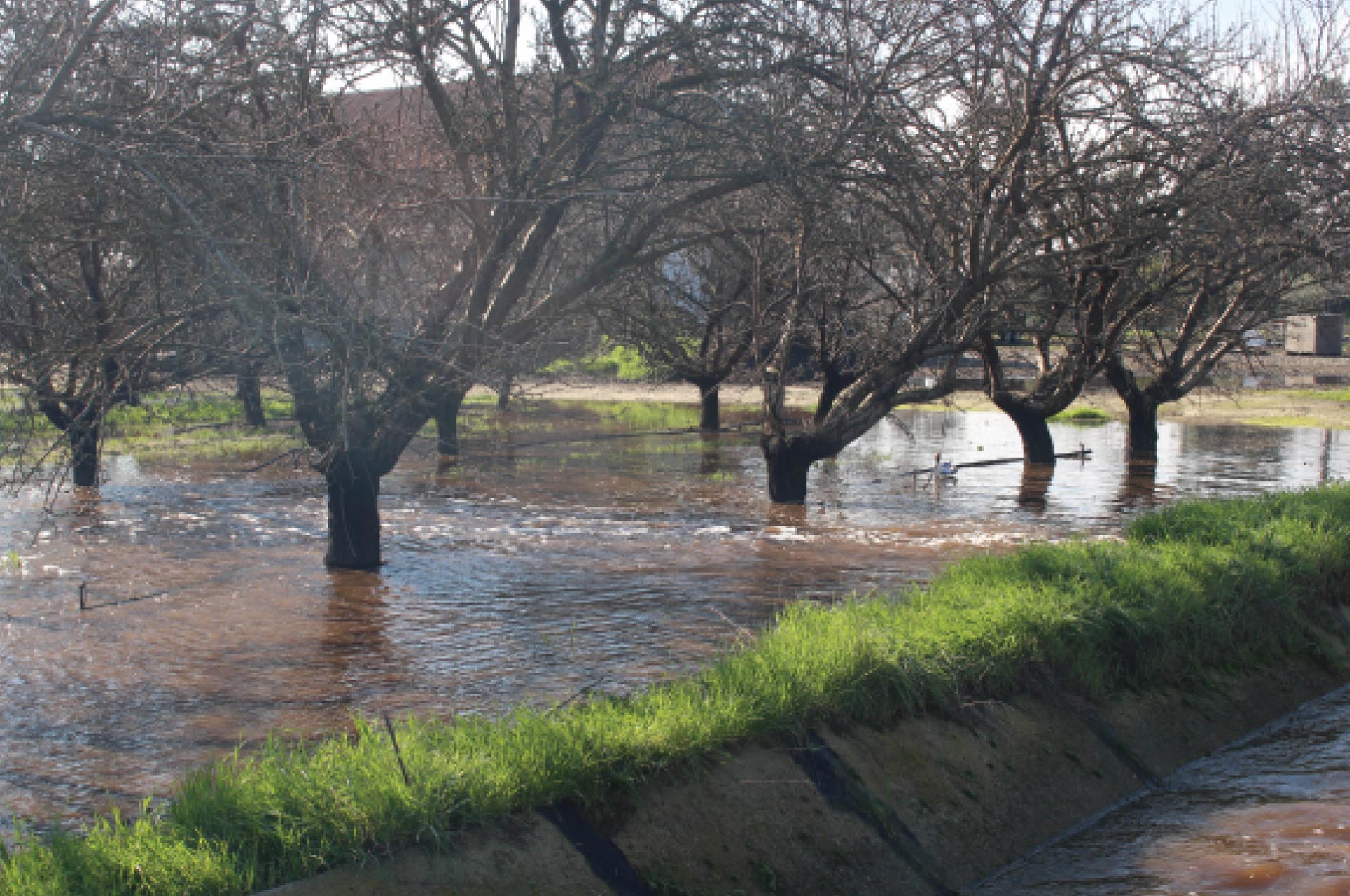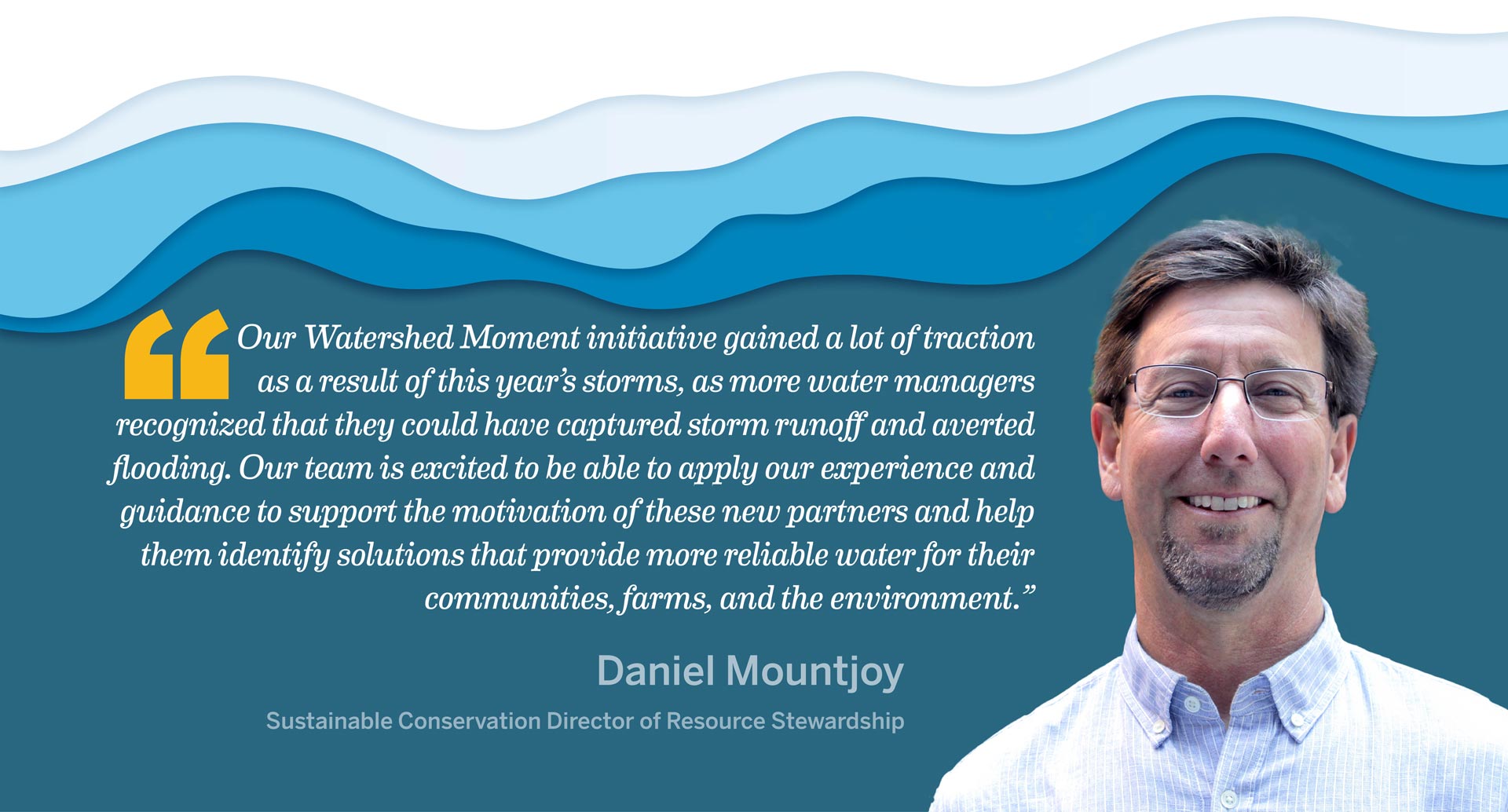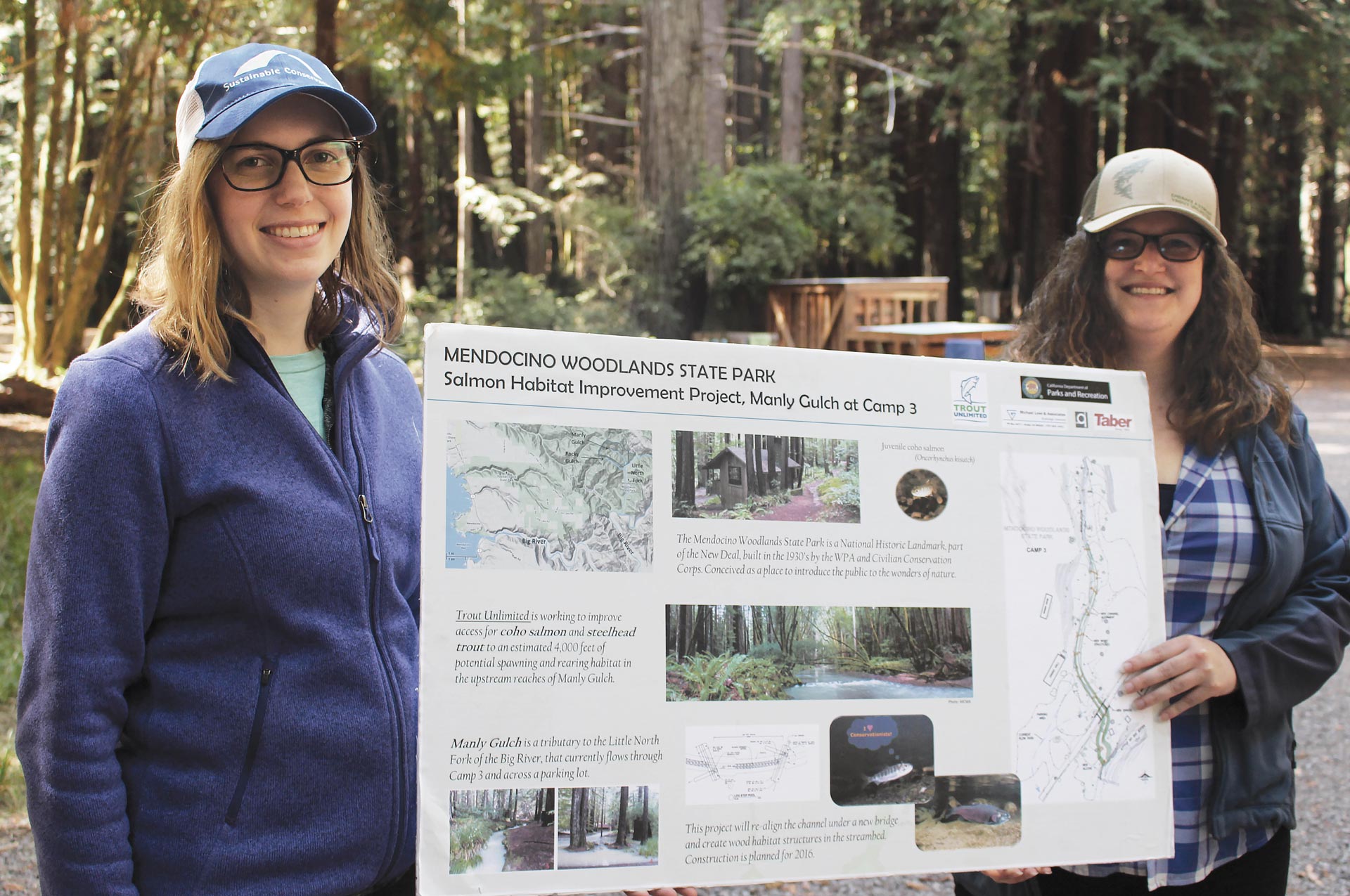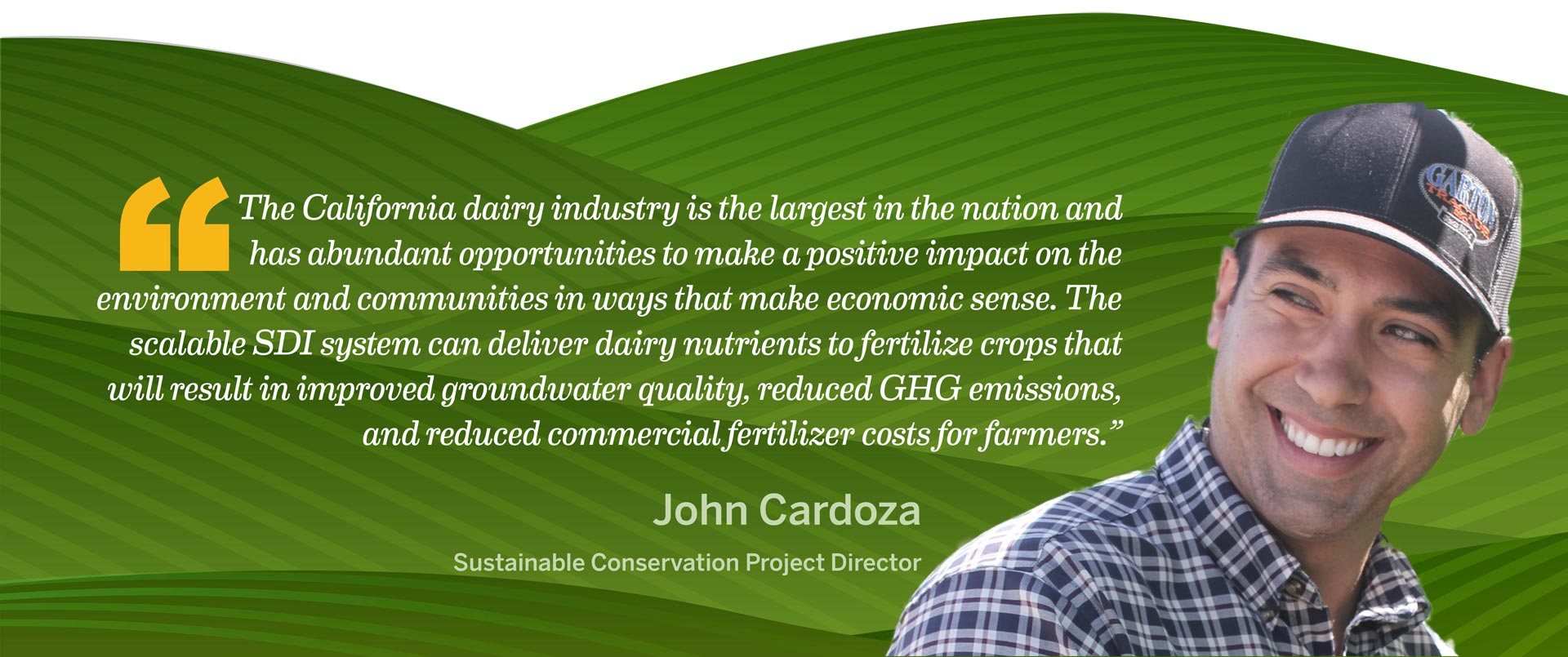
Dwindling groundwater aquifers. Extreme flooding. Wildfire risk. Struggling species. Drinking water insecurity. California’s resource constraints only become clearer the more our climate changes. It can be overwhelming to understand how we currently use water in the state, much less how we can manage it for the future.
2023 marks Sustainable Conservation’s 30th year of working to ensure sufficient, clean water for the environment, communities, and farming. We are excited to build on three decades of tangible success, deep experience, and trusted partnerships to advance 21st-century water management in California.
Unhealthy watersheds mean poor health outcomes for ecosystems and people. We want to solve for climate risk, but nature doesn’t conform to human boundaries.
Why, then, do we silo our solutions? Sierra streams start high above our patchwork valley farmland, but those same waters flow past fields and into our towns and cities. Salmon and birds travel across our state and beyond in their lifetimes, and what’s good for their habitat is good for ours. People form generational communities around economic sectors – especially farms – so “sustainable” solutions must include human welfare.
It’s clear that effective and equitable water management isn’t just about quantity, but what do we really mean by “multi-benefit” or a “whole-systems approach?”
As we celebrate our 30th anniversary, we’re bringing our programs together to connect floodplain restoration to groundwater replenishment, soil health to water quality, and salmon health to human health to transform our water system.
Our weather whiplash this year was severe and momentary relief was swiftly overcome by floodwaters ravaging homes, fields, and ecosystems alike. Now we face more water uncertainty this fall, wildfire threats as temperatures rise and enduring drinking water inequity as reservoirs fill but aquifers do not.
What’s more, a looming El Niño may mean another wet winter, so we need to be ready.
If California is to have a secure environmental and economic future, we must do work that affects not just one field, aquifer, or river. We can, and should, act in ways that benefit entire watersheds, and the whole state.
Water is our touchstone, and this is our watershed moment.
Best,

Ashley Boren


The water available from our intense storms this year meant that the growers and water managers we work with could, and did, take water for recharge. State officials are working hard to clarify policy and permitting requirements, but it’s clear we need to do more wherever we can to adapt to our new climate realities.

We announced our Watershed Moment Initiative work last spring, and since then we’ve worked with a broad coalition of people, agencies, companies, and foundations to help us scale our watershed modeling with the Department of Water Resources to the five watersheds that drain from the Sierras into the San Joaquin River.
Our initial Merced River watershed study showed that if we use existing conveyance alone, we can address 31% of the annual groundwater overdraft problem in that watershed.
The watershed study findings have enormous potential to catalyze much of the on-the-ground (and in-the-ground!) work that we and our partners do every day. Each watershed has its own challenges, but challenges are also opportunities and we’re adapting solutions to local problems.
Connections
When we consider water availability, whether people can use that water is a key issue for hundreds of California communities near farms. As groundwater dwindles during drought due to pumping, the problem only gets worse.
Siting groundwater recharge to benefit water quality requires careful, collaborative planning with local communities and water managers. But, if we recharge in the right places and in the right amounts, we can dilute legacy pollution and refill our aquifers at the same time.


Rivers and streams are the lifeblood of a watershed. They regulate water quality, provide wildlife habitat, irrigate our food, give us recreation, and are a barometer of natural and human health. However, human development and pollution threaten our waterways – and the ecosystems and communities that depend on them.
Restoration advocates want to help, but regulatory approval can be slow, complex, and expensive. We work with agencies and statewide coalitions to “cut the green tape” by expediting permitting processes for river restoration projects while maintaining strict environmental standards.
More efficient permitting pathways means more restoration can be done now, not years from now.
From county-level programs to multi-agency statewide permits, Accelerating Restoration’s impact has grown exponentially in three decades. We netted two significant statewide wins in 2022, and habitat projects ranging from Sierra meadows to Sacramento river sloughs to coastal creeks are already using these improved permitting pathways to expand the scope of their work while reducing waiting periods. And, when state and federal funding is available, restorationists can act to secure those vital dollars for the project itself – not costly permits.
Ecosystem management at a watershed level is within our reach. By thinking beyond individual projects, we can create a sustainable and interconnected network of healthy rivers that benefit both nature and people.

Connections
Reconnecting floodplains to healthy rivers can also recharge groundwater during wet years. An accessible floodplain invites stream runoff to slow swift water that can threaten downstream communities.
Floodplains also create critical migratory bird and salmonid habitat, and function as temporary recharge basins where water can percolate into our aquifers. They’re a key part of our watershed work, and a proven multi-benefit solution for California.

We don’t always see farms as part of our watersheds, but they often border critical waterways and sensitive habitat – so how they’re managed really matters.
This spring, we announced our new Solutions in our Soil program and shared why soil health is key to our mission, and integral to our vision for truly sustainable progress.
There’s a complex world of microorganisms beneath our feet, and we can’t grow the food we need or conserve our precious water resources without making sure our soils can retain water, cycle nutrients, and sequester carbon.
With only 5% of California farmers doing things like applying compost, planting cover crops, or using low-impact tillage on irrigated agriculture, we need to know what’s possible in our current regulatory, economic, and equity landscape.
We’re exploring exciting strategies like high-carbon soil amendments that boost microbial communities and keep nitrogen from leaching into our aquifers. Cover cropping has big potential to help farmers improve how much water can infiltrate their soils for plant use, groundwater recharge, and reduce runoff during storms. Compost application can build soil health and improve carbon sequestration. And, low-impact tillage means fewer disturbances to our soil with added benefits like reduced labor and fuel costs.
There is no one-size fits all solution for soil health.
Our expertise and collaborative approach can help people understand what’s right for the ecosystem in which they farm, and what incentives are out there to help them try new things within their budgets.

Connections

California dairy farmers — who produce more pounds of dairy products each year than any other state — face compounding pressures from a changing climate and an increasingly stringent regulatory environment. It is more vital than ever for California dairies to have access to forward-thinking solutions to best manage the manure their cows produce, steward their water resources, reduce their environmental footprint, and stay economically viable.
We’re expanding our award-winning, first-of-its-kind manure drip irrigation system (SDI) as a powerful tool for farmers to use on-farm nutrients to cut synthetic fertilizer costs, reduce greenhouse gas emissions (GHGs,) avoid applying excess nitrogen, and even save precious water during droughts. Dairies of all sizes and budgets can use this incredible technology and be part of the California water sustainability solution.

Looking forward, we hope to diversify the types of crops that can be irrigated using SDI. While the system was piloted on dairy farms by applying a blend of manure and water to nourish silage used for cow feed, food crops must be fertilized and processed for human consumption within stricter safety standards.
We’re working towards a future where pasteurized, human-consumed crops like almonds and processed tomatoes can be precisely watered and fertilized with SDI to give dairy producers a potential revenue stream and export option for their manure byproducts.
SDI benefits the environment, growers, and consumers alike for a resilient and sustainable agricultural industry.
Connections
SDI can protect groundwater quality for adjacent communities and reduce overall agricultural water demand in California. And, the excess manure dairies produce can be composted and potentially used on other crops to boost soil health in compliance with food safety standards and reduce GHG emissions.
Accessible, proven manure management technologies can help create a true circular economy wherein dairies can recycle or even export their outputs, and conserve their resources and inputs.
